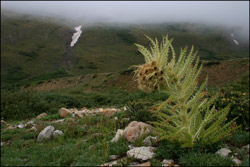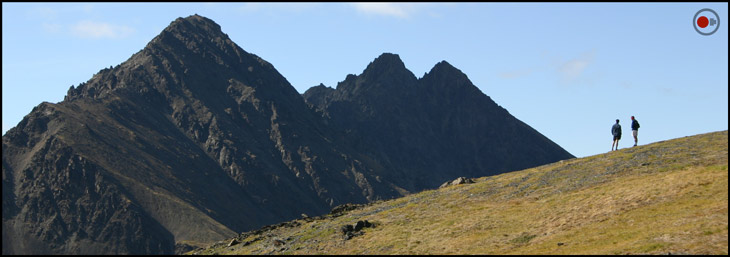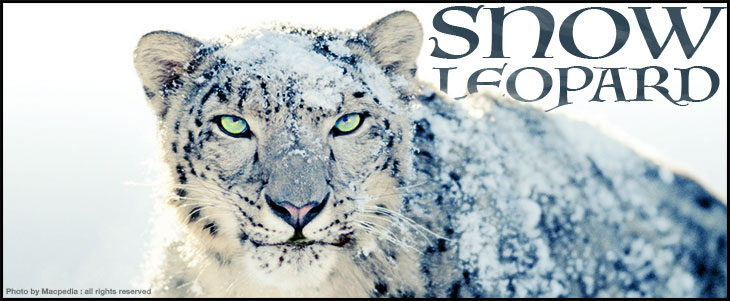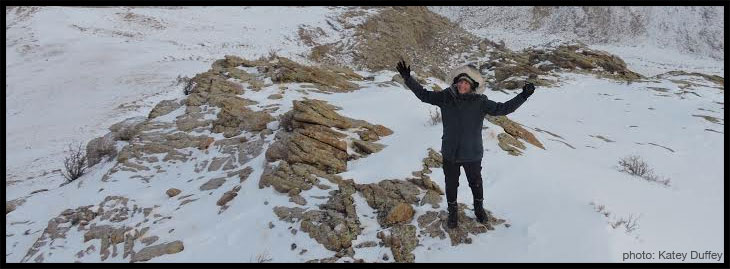The Alpine Tundra Biome
The Alpine Tundra is one of my favorite places in the world. I’m a native Coloradan, after all, so it’s kinda in my blood. Plus, I’ve climbed my fair share of mountains. I’ve even made a few movies on mountains, like a 3D movie on the Grand Teton and the “original” Alpine Tundra Video with The Wild Classroom. It seemed appropriate for me to give a quick overview of this biome.
The word tundra comes from the Sami people of Northern Finland, Sweden and Norway and means “land of no trees.” Similar to the arctic tundra, the Alpine Tundra also has no trees.
Yet unlike the arctic tundra, which is restricted to high latitudes, the alpine tundra can be found anywhere on Earth. It is dependent only on elevation. Anywhere you have high enough elevations to keep trees from growing, you can find the alpine tundra. That means you can have alpine tundra on high mountains in Mexico, Kenya, Colorado and Alaska.
The Merriam Life Zones
Just as the desert can fade into rainforest depending on a gradient of rainfall, a gradient of biomes or life zones can also be established around elevation. This is exactly what C. Hart Merriam did in the late 1800’s. He was a land surveyor who mapped the West from the bottom of the Grand Canyon to the top of the mountain peaks. He noticed distinct plant communities as elevation increased. The lowest were prairies, followed by dry steppes, Ponderosa Pine, montane forests, subalpine forests and finally the Alpine Tundra. In each of these zones, the plants were well-adapted to the climate that existed.
The Climate of the Alpine Tundra
The Alpine Tundra, while high in elevation, mirrors the Arctic Tundra in many ways. One of the most notable similarities is the tendency for the Alpine Tundra to get covered by snow for a large portion of the year. This makes the growing season short for most plants. Wind at these elevations can also cause a great deal of desiccation (drying out the plants).
The Diverse Landscape of the Alpine Tundra
Don’t think that the Alpine Tundra is an unchanging habitat sitting on top of a mountain. Quite the contrary. In fact, small changes in elevation and patches of snow and rock can create small habitats that different critters can take advantage of. For instance, a small depression in the ground can decrease wind and sun intensity so that snow accumulates there year round. These snowbanks are hard places for plants and animals to grow. Some of the major micro-habitats found in the Alpine Tundra are meadows, snow-beds, talus fields, and fell-fields. You can only imagine how different the plant communities might be in these different habitats.
Animal Adaptations
Very few animals are found in this habitat year round. Some of the few that do make their home here year-round are yellow-bellied marmots, pikas, and ptarmagins. Each has unique adaptations to allow them to live here. Yellow-bellied marmots that live in Colorado will hibernate for as many as eight months out of the year. Pikas don’t hibernate; they hide from the weather under rocks in the boulder fields. They store food in haypiles and munch them until real food is available. Pikas are related to rabbits and hares, not rodents.
Plant Adaptations
- The dark colors of alpine plants absorb heat.
- The plants have anthocyanins, pigments that create red or blue, and can convert light into heat.
- Plants are slow-growing, making them vulnerable to human foot-traffic.
- Most plants are long-lived perennial plants. They don’t grow stems, leaves, flowers and fruit each season.
- Plants are matted against the earth, keeping them away from harmful wind.
- Some plants have hairs which allow them to trap heat and diffuse the harmful solar radiation.
- Some plants are succulents, storing water in their leaves (waxy leaves that prevent desiccation).
Alpine Tundra Animals
A few of the common North American animals if the alpine tundra are Marmots, Mountain Goats, Bighorn Sheep, and Pika. However one of the most famous worldwide is the Snow Leopard.
Alpine Tundra Plants
 There are lots of different plants that grow in the alpine tundra. In fact, many of the species that grow in these mountainous zones are found only on a handful of mountains. That’s because the tops of the mountains are often isolated from one another.
There are lots of different plants that grow in the alpine tundra. In fact, many of the species that grow in these mountainous zones are found only on a handful of mountains. That’s because the tops of the mountains are often isolated from one another.
Notable plants that grow in this area though are the Bristlecone Pine (the oldest tree in the world), Forget-me-nots, Alpine Sunflowers, and Saxifrags.
Next time you’re wandering through the mountains in the summer, take a second to look at the plants that grow here. Just make sure you’re careful not to disturb this habitat as they take a long time to grow back. That means you should stick to designated trails and hop from rock to rock if you have to go off-trail.
Researchers that work in the Alpine Tundra
Katey Duffey
Katey is a snow leopard researcher. She spends her field seasons in the mountains of Mongolia whereby she tries to track down these elusive cats. They’re not easy to find. In fact, its very rare to see one in person. Most of the time you find their scat (poop) or see glimpses of them on the trail cameras. Read more about what life is like for Katey here.
Related Topics
The Alpine Tundra is one of my favorite places in the world. I’m a native Coloradan, after all, so it’s kinda in my blood. Plus, I’ve climbed my fair share of mountains. I’ve even made a few movies on mountains, like a 3D movie on the Grand Teton and the “original” Alpine Tundra Video with The Wild Classroom. It seemed appropriate for me to give a quick overview of this biome.
The word tundra comes from the Sami people of Northern Finland, Sweden and Norway and means “land of no trees.” Similar to the arctic tundra, the Alpine Tundra also has no trees.
Yet unlike the arctic tundra, which is restricted to high latitudes, the alpine tundra can be found anywhere on Earth. It is dependent only on elevation. Anywhere you have high enough elevations to keep trees from growing, you can find the alpine tundra. That means you can have alpine tundra on high mountains in Mexico, Kenya, Colorado and Alaska.
The Merriam Life Zones
Just as the desert can fade into rainforest depending on a gradient of rainfall, a gradient of biomes or life zones can also be established around elevation. This is exactly what C. Hart Merriam did in the late 1800’s. He was a land surveyor who mapped the West from the bottom of the Grand Canyon to the top of the mountain peaks. He noticed distinct plant communities as elevation increased. The lowest were prairies, followed by dry steppes, Ponderosa Pine, montane forests, subalpine forests and finally the Alpine Tundra. In each of these zones, the plants were well-adapted to the climate that existed.
The Climate of the Alpine Tundra
The Alpine Tundra, while high in elevation, mirrors the Arctic Tundra in many ways. One of the most notable similarities is the tendency for the Alpine Tundra to get covered by snow for a large portion of the year. This makes the growing season short for most plants. Wind at these elevations can also cause a great deal of desiccation (drying out the plants).
The Diverse Landscape of the Alpine Tundra
Don’t think that the Alpine Tundra is an unchanging habitat sitting on top of a mountain. Quite the contrary. In fact, small changes in elevation and patches of snow and rock can create small habitats that different critters can take advantage of. For instance, a small depression in the ground can decrease wind and sun intensity so that snow accumulates there year round. These snowbanks are hard places for plants and animals to grow. Some of the major micro-habitats found in the Alpine Tundra are meadows, snow-beds, talus fields, and fell-fields. You can only imagine how different the plant communities might be in these different habitats.
Animal Adaptations
Very few animals are found in this habitat year round. Some of the few that do make their home here year-round are yellow-bellied marmots, pikas, and ptarmagins. Each has unique adaptations to allow them to live here. Yellow-bellied marmots that live in Colorado will hibernate for as many as eight months out of the year. Pikas don’t hibernate; they hide from the weather under rocks in the boulder fields. They store food in haypiles and munch them until real food is available. Pikas are related to rabbits and hares, not rodents.
Plant Adaptations
- The dark colors of alpine plants absorb heat.
- The plants have anthocyanins, pigments that create red or blue, and can convert light into heat.
- Plants are slow-growing, making them vulnerable to human foot-traffic.
- Most plants are long-lived perennial plants. They don’t grow stems, leaves, flowers and fruit each season.
- Plants are matted against the earth, keeping them away from harmful wind.
- Some plants have hairs which allow them to trap heat and diffuse the harmful solar radiation.
- Some plants are succulents, storing water in their leaves (waxy leaves that prevent desiccation).
Alpine Tundra Animals
A few of the common North American animals if the alpine tundra are Marmots, Mountain Goats, Bighorn Sheep, and Pika. However one of the most famous worldwide is the Snow Leopard.
Alpine Tundra Plants
 There are lots of different plants that grow in the alpine tundra. In fact, many of the species that grow in these mountainous zones are found only on a handful of mountains. That’s because the tops of the mountains are often isolated from one another.
There are lots of different plants that grow in the alpine tundra. In fact, many of the species that grow in these mountainous zones are found only on a handful of mountains. That’s because the tops of the mountains are often isolated from one another.
Notable plants that grow in this area though are the Bristlecone Pine (the oldest tree in the world), Forget-me-nots, Alpine Sunflowers, and Saxifrags.
Next time you’re wandering through the mountains in the summer, take a second to look at the plants that grow here. Just make sure you’re careful not to disturb this habitat as they take a long time to grow back. That means you should stick to designated trails and hop from rock to rock if you have to go off-trail.
Researchers that work in the Alpine Tundra
Katey Duffey
Katey is a snow leopard researcher. She spends her field seasons in the mountains of Mongolia whereby she tries to track down these elusive cats. They’re not easy to find. In fact, its very rare to see one in person. Most of the time you find their scat (poop) or see glimpses of them on the trail cameras. Read more about what life is like for Katey here.





































































































